High Luminous Efficacy Phosphor-Converted Mass-Produced White LEDs Achieved by AlN Prebuffer and Transitional-Refraction-Index Patterned Sapphire Substrate
Abstract
:1. Introduction
2. Materials and Methods
3. Results and Discussion
3.1. PVD AlN Prebuffer Layer
3.2. TPSS Technology
3.3. High Light Output Power BLED
3.4. High Luminous Efficacy WLED
4. Conclusions
Supplementary Materials
Author Contributions
Funding
Institutional Review Board Statement
Informed Consent Statement
Data Availability Statement
Conflicts of Interest
References
- Nakamura, S. Current Status of GaN-Based SolidState Lighting. MRS Bull. 2009, 34, 101–107. [Google Scholar] [CrossRef]
- Zhang, Y.; Xie, H.; Zheng, H.; Wei, T.; Yang, H.; Li, J.; Yi, X.; Song, X.; Wang, G.; Li, J. Light extraction efficiency improvement by multiple laser stealth dicing in InGaN-based blue light-emitting diodes. Opt. Express 2012, 20, 6808–6815. [Google Scholar] [CrossRef] [PubMed]
- Wu, H.; Li, H.; Kuo, S.-Y.; Chen, B.-Y.; Lu, T.-C.; Huang, H. High Output Power GaN-Based Green Resonant-Cavity Light-Emitting Diodes with Trapezoidal Quantum Wells. IEEE Trans. Electron Devices 2020, 67, 3650–3654. [Google Scholar] [CrossRef]
- Ponce, F.A.; Bour, D.P. Nitride-based semiconductors for blue and green light-emitting devices. Nature 1997, 386, 351–359. [Google Scholar] [CrossRef]
- Wu, T.; Sher, C.-W.; Lin, Y.; Lee, C.-F.; Liang, S.; Lu, Y.; Chen, S.-W.H.; Guo, W.; Kuo, H.-C.; Chen, Z. Mini-LED and Micro-LED: Promising Candidates for the Next Generation Display Technology. Appl. Sci. 2018, 8, 1557. [Google Scholar] [CrossRef] [Green Version]
- Zhang, S.; Yan, Y.; Feng, T.; Yin, Y.; Ren, F.; Liang, M.; Wu, C.; Yi, X.; Wang, J.; Li, J.; et al. Wafer-Scale Semipolar Micro-Pyramid Lighting-Emitting Diode Array. Crystals 2021, 11, 686. [Google Scholar] [CrossRef]
- Huang, Y.; Guo, Z.; Wang, X.; Li, H.; Xiang, D. GaN-Based High-Response Frequency and High-Optical Power Matrix Micro-LED for Visible Light Communication. IEEE Electron Device Lett. 2020, 41, 1536–1539. [Google Scholar] [CrossRef]
- Singh, K.J.; Huang, Y.-M.; Ahmed, T.; Liu, A.-C.; Chen, S.-W.H.; Liou, F.-J.; Wu, T.; Lin, C.-C.; Chow, C.-W.; Lin, G.-R.; et al. Micro-LED as a Promising Candidate for High-Speed Visible Light Communication. Appl. Sci. 2020, 10, 7384. [Google Scholar] [CrossRef]
- Li, M.; Zhang, X.; Zhang, H.; Chen, W.; Ma, L.; Wang, X.; Liu, Y.; Lei, B. Highly efficient and dual broad emitting light convertor: An option for next-generation plant growth LEDs. J. Mater. Chem. C 2019, 7, 3617–3622. [Google Scholar] [CrossRef]
- Lin, C.; Zhan, T.; Liu, Z.; Yi, X.; Xie, H.; Wang, J.; Li, J. A Wirelessly Controllable Optoelectronic Device for Optogenetics. IEEE. Photon-Technol. Lett. 2019, 31, 915–918. [Google Scholar] [CrossRef]
- Cheng, I.-H.; McBride, J.; Decker, M.; Watson, T.; Jakubenko, H.; Russo, A. The asylum seeker integrated healthcare pathway: A collaborative approach to improving access to primary health care in South Eastern Melbourne, Victoria, Australia. Aust. J. Prim. Health 2019, 25, 6–12. [Google Scholar] [CrossRef] [PubMed]
- Pimputkar, S.; Speck, J.S.; Steven, P.D.; Nakamura, S. Prospects for LED lighting. Nat. Photonics 2009, 3, 180–182. [Google Scholar] [CrossRef]
- Chen, Z.; Zhang, X.; Dou, Z.; Wei, T.; Liu, Z.; Qi, Y.; Ci, H.; Wang, Y.; Li, Y.; Chang, H.; et al. High-Brightness Blue Light-Emitting Diodes Enabled by a Directly Grown Graphene Buffer Layer. Adv. Mater. 2018, 30, e1801608. [Google Scholar] [CrossRef] [PubMed]
- Liu, Y.; Silver, J.; Xie, R.-J.; Zhang, J.; Xu, H.; Shao, H.; Jiang, J.; Jiang, H. An excellent cyan-emitting orthosilicate phosphor for NUV-pumped white LED application. J. Mater. Chem. C 2017, 5, 12365–12377. [Google Scholar] [CrossRef]
- Khan, W.U.; Zhou, L.; Li, X.; Zhou, W.; Khan, D.; Niaz, S.-I.; Wu, M. Single phase white LED phosphor Ca3YAl3B4O15:Ce3+,Tb3+,Sm3+ with superior performance: Color-tunable and energy transfer study. Chem. Eng. J. 2021, 410, 128455. [Google Scholar] [CrossRef]
- Chandra, F.; Wahyudianto, A.; Yasin, M. Design of vein finder with multi tuning wavelength using RGB LED. J. Phys. Conf. Ser. 2017, 853, 012019. [Google Scholar] [CrossRef]
- TEHNOBLOG. SMD LED Chips Characteristics: Size, Power, Efficacy. Available online: https://tehnoblog.org/smd-led-chips-characteristics-size-power-efficiency/ (accessed on 24 August 2021).
- United States Department of Energy. 2019 Lighting R&D Opportunities; United States Department of Energy: Washington, DC, USA, 2020.
- Cree, I. Cree First to Break 300 Lumens-Per-Watt Barrier. Available online: https://www.wolfspeed.com/company/news-events/news/cree-first-to-break-300-lumens-per-watt-barrier (accessed on 26 March 2014).
- Amano, H.; Sawaki, N.; Akasaki, I.; Toyoda, Y. Metalorganic vapor phase epitaxial growth of a high quality GaN film using an AlN buffer layer. Appl. Phys. Lett. 1986, 48, 353–355. [Google Scholar] [CrossRef] [Green Version]
- He, C.; Zhao, W.; Zhang, K.; He, L.; Wu, H.; Liu, N.; Zhang, S.; Liu, X.; Chen, Z. High-Quality GaN Epilayers Achieved by Facet-Controlled Epitaxial Lateral Overgrowth on Sputtered AlN/PSS Templates. ACS Appl. Mater. Interfaces 2017, 9, 43386–43392. [Google Scholar] [CrossRef]
- Lee, D.; Lee, S.; Kim, G.; Kim, J.; Jang, J.; Oh, J.; Moon, D.; Park, Y.; Yoon, E. Epitaxial lateral overgrowth of GaN on nano-cavity patterned sapphire substrates. J. Cryst. Growth 2019, 507, 103–108. [Google Scholar] [CrossRef]
- Chao, S.-H.; Yeh, L.-H.; Wu, R.T.; Kawagishi, K.; Hsu, S.-C. Novel patterned sapphire substrates for enhancing the efficiency of GaN-based light-emitting diodes. RSC Adv. 2020, 10, 16284–16290. [Google Scholar] [CrossRef] [Green Version]
- Cho, J.-Y.; Kim, J.-S.; Kim, Y.-D.; Cha, H.J.; Lee, H. Fabrication of oxide-based nano-patterned sapphire substrate to improve the efficiency of GaN-based of LED. Jpn. J. Appl. Phys. 2015, 54, 02BA04. [Google Scholar] [CrossRef]
- Prajoon, P.; Menokey, M.A.; Pravin, J.C.; Ajayan, J.; Rajesh, S.; Nirmal, D. Investigation of efficiency enhancement in InGaN MQW LED with compositionally step graded GaN/InAlN/GaN multi-layer barrier. Superlattice Microstruct. 2018, 116, 71–78. [Google Scholar] [CrossRef]
- Karan, H.; Biswas, A. Improving performance of light-emitting diodes using InGaN/GaN MQWs with varying trapezoidal bottom well width. Optik 2021, 247, 167888. [Google Scholar] [CrossRef]
- Usman, M.; Munsif, M.; Anwar, A.-R. Wedge-shaped electron blocking layer to improve hole transport and efficiency in green light-emitting diodes. Opt. Commun. 2020, 464, 125493. [Google Scholar] [CrossRef]
- Wang, T.-H.; Xu, J.-L. Advantage of InGaN-based light-emitting diodes with trapezoidal electron blocking layer. Mater. Sci. Semicond. Process. 2015, 29, 95–101. [Google Scholar] [CrossRef]
- Liu, Z.; Yi, X.; Yu, Z.; Yuan, G.; Liu, Y.; Wang, J.; Li, J.; Lu, N.; Ferguson, I.; Zhang, Y. Impurity Resonant States p-type Doping in Wide-Band-Gap Nitrides. Sci. Rep. 2016, 6, 19537. [Google Scholar] [CrossRef]
- Moon, Y.-J.; Moon, D.-Y.; Jang, J.; Na, J.-Y.; Song, J.-H.; Seo, M.-K.; Kim, S.; Bae, D.; Park, E.H.; Park, Y.; et al. Microstructured Air Cavities as High-Index Contrast Substrates with Strong Diffraction for Light-Emitting Diodes. Nano Lett. 2016, 16, 3301–3308. [Google Scholar] [CrossRef]
- Zhou, S.; Liu, X.; Yan, H.; Chen, Z.; Liu, Y.; Liu, S. Highly efficient GaN-based high-power flip-chip light-emitting diodes. Opt. Express 2019, 27, A669–A692. [Google Scholar] [CrossRef]
- Lee, G.S.; Lee, C.; Jeon, H.; Lee, C.; Bae, S.G.; Ahn, H.S.; Yang, M.; Yi, S.N.; Yu, Y.M.; Lee, J.H.; et al. Growth of AlN layer on patterned sapphire substrate by hydride vapor phase epitaxy. Jpn. J. Appl. Phys. 2016, 55, 05FC02. [Google Scholar] [CrossRef]
- Zhu, H.; Lin, C.C.; Luo, W.; Shu, S.; Liu, Z.; Liu, Y.; Kong, J.; Ma, E.; Cao, Y.; Liu, R.-S.; et al. Highly efficient non-rare-earth red emitting phosphor for warm white light-emitting diodes. Nat. Commun. 2014, 5, 4312. [Google Scholar] [CrossRef] [Green Version]
- Pust, P.; Weiler, V.; Hecht, C.; Tücks, A.; Wochnik, A.S.; Henß, A.-K.; Wiechert, D.; Scheu, C.; Schmidt, P.J.; Schnick, W. Narrow-band red-emitting Sr[LiAl3N4]:Eu2+ as a next-generation LED-phosphor material. Nat. Mater. 2014, 13, 891–896. [Google Scholar] [CrossRef] [PubMed]
- Yang, X.; Zhang, J.; Wang, X.; Zheng, C.; Quan, Z.; Jiang, F. Enhance the efficiency of green-yellow LED by optimizing the growth condition of preparation layer. Superlattices Microstruct. 2020, 141, 106459. [Google Scholar] [CrossRef]
- Park, J.H.; Kim, D.Y.; Hwang, S.; Meyaard, D.; Schubert, E.F.; Han, Y.D.; Choi, J.W.; Cho, J.; Kim, J.K. Enhanced overall efficiency of GaInN-based light-emitting diodes with reduced efficiency droop by Al-composition-graded AlGaN/GaN superlattice electron blocking layer. Appl. Phys. Lett. 2013, 103, 061104. [Google Scholar] [CrossRef] [Green Version]
- Li, L.; Stegmann, P.G.; Rosenkranz, S.; Schäfer, W.; Tropea, C. Simulation of light scattering from a colloidal droplet using a polarized Monte Carlo method: Application to the time-shift technique. Opt. Express 2019, 27, 36388–36404. [Google Scholar] [CrossRef]
- Zhang, S.; Liu, B.; Ren, F.; Yin, Y.; Wang, Y.; Chen, Z.; Jiang, B.; Liu, B.; Liu, Z.; Sun, J.; et al. Graphene-Nanorod Enhanced Quasi-Van Der Waals Epitaxy for High Indium Composition Nitride Films. Small 2021, 17, e2100098. [Google Scholar] [CrossRef]
- Nakamura, S. GaN Growth Using GaN Buffer Layer. Jpn. J. Appl. Phys. 1991, 30, L1705–L1707. [Google Scholar] [CrossRef]
- Ni, R.; Chen, X.; Yan, J.; Zhang, L.; Guo, Y.; Wang, J.; Li, J.; Zhang, Y. Reducing stimulated emission threshold power density of AlGaN/AlN multiple quantum wells by nano-trench-patterned AlN template. J. Alloys Compd. 2019, 777, 344–349. [Google Scholar] [CrossRef]
- Chiu, C.-H.; Lin, D.-W.; Li, Z.-Y.; Chiu, C.-H.; Chao, C.-L.; Tu, C.-C.; Kuo, H.-C.; Lu, T.-C.; Wang, S.-C. Improvement in Crystalline Quality of InGaN-Based Epilayer on Sapphire via Nanoscaled Epitaxial Lateral Overgrowth. Jpn. J. Appl. Phys. 2010, 49, 105501. [Google Scholar] [CrossRef]
- Kaufmann, U.; Kunzer, M.; Obloh, H.; Maier, M.; Manz, C.; Ramakrishnan, A.; Santic, B. Origin of defect-related photoluminescence bands in doped and nominally undoped GaN. Phys. Rev. B 1999, 59, 5561–5567. [Google Scholar] [CrossRef]
- Wu, F.-L.; Ou, S.-L.; Kao, Y.-C.; Chen, C.-L.; Tseng, M.-C.; Lu, F.-C.; Lin, M.-T.; Horng, R.-H. Thin-film vertical-type AlGaInP LEDs fabricated by epitaxial lift-off process via the patterned design of Cu substrate. Opt. Express 2015, 23, 18156–18165. [Google Scholar] [CrossRef]
- Bi, Z.; Gustafsson, A.; Lenrick, F.; Lindgren, D.; Hultin, O.; Wallenberg, L.R.; Ohlsson, B.J.; Monemar, B.; Samuelson, L. High In-content InGaN nano-pyramids: Tuning crystal homogeneity by optimized nucleation of GaN seeds. J. Appl. Phys. 2018, 123, 025102. [Google Scholar] [CrossRef]
- Kioupakis, E.; Yan, Q.; Van de Walle, C.G. Interplay of polarization fields and Auger recombination in the efficiency droop of nitride light-emitting diodes. Appl. Phys. Lett. 2012, 101, 231107. [Google Scholar] [CrossRef] [Green Version]
- Li, H.; Li, P.; Kang, J.; Li, Z.; Zhang, Y.; Liang, M.; Li, Z.; Li, J.; Yi, X.; Wang, G. Analysis Model for Efficiency Droop of InGaN Light-Emitting Diodes Based on Reduced Effective Volume of Active Region by Carrier Localization. Appl. Phys. Express 2013, 6, 092101. [Google Scholar] [CrossRef]

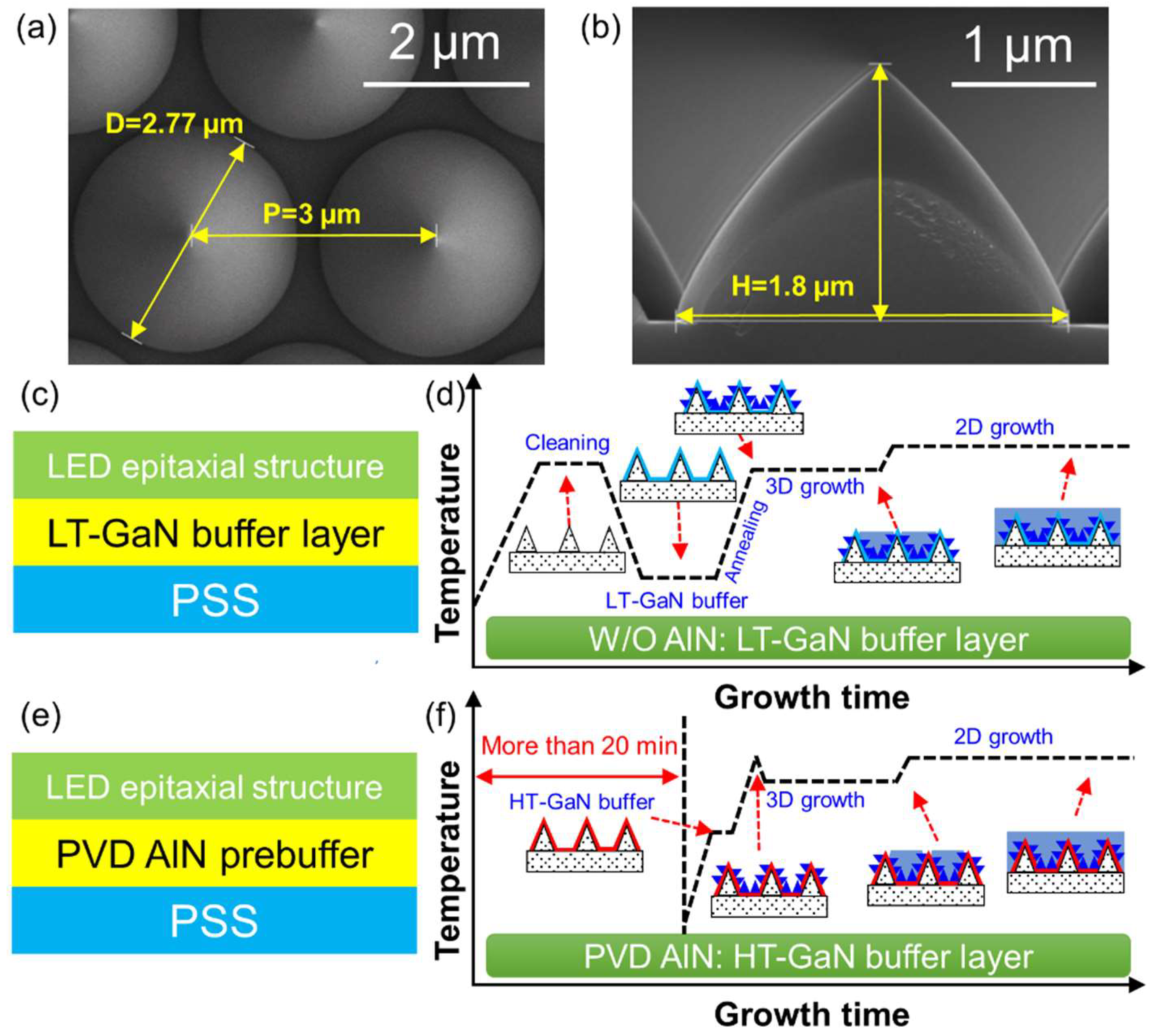
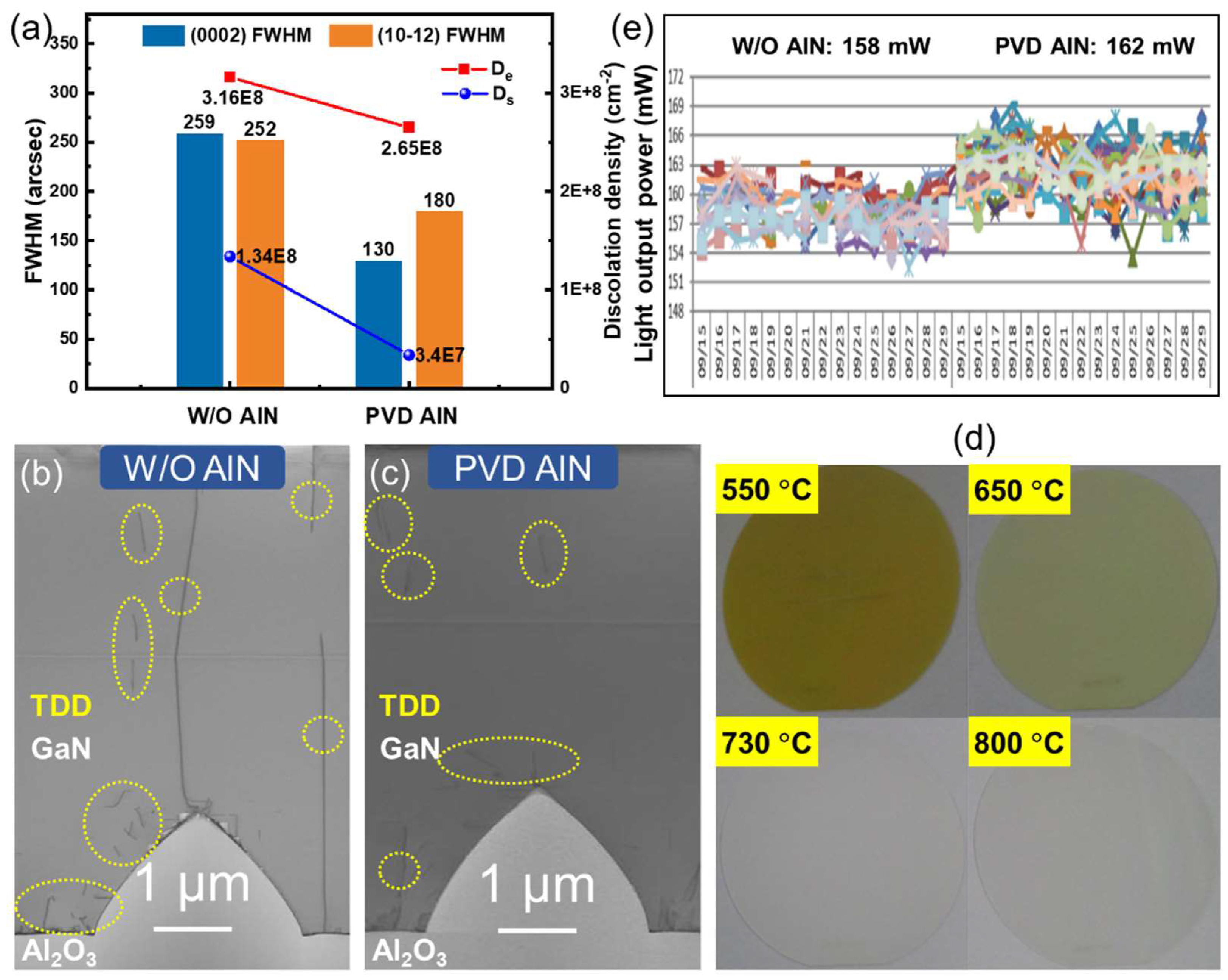
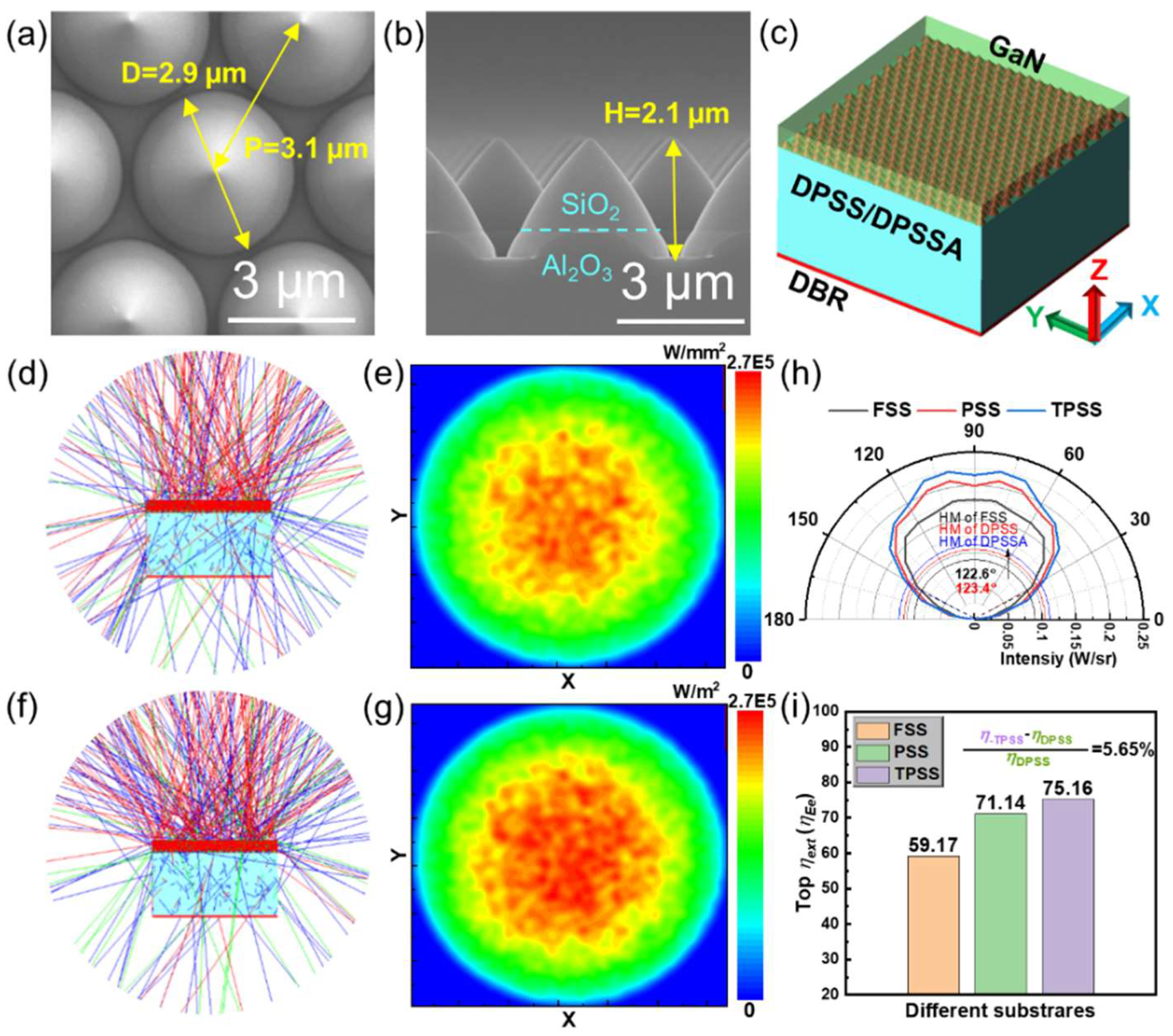

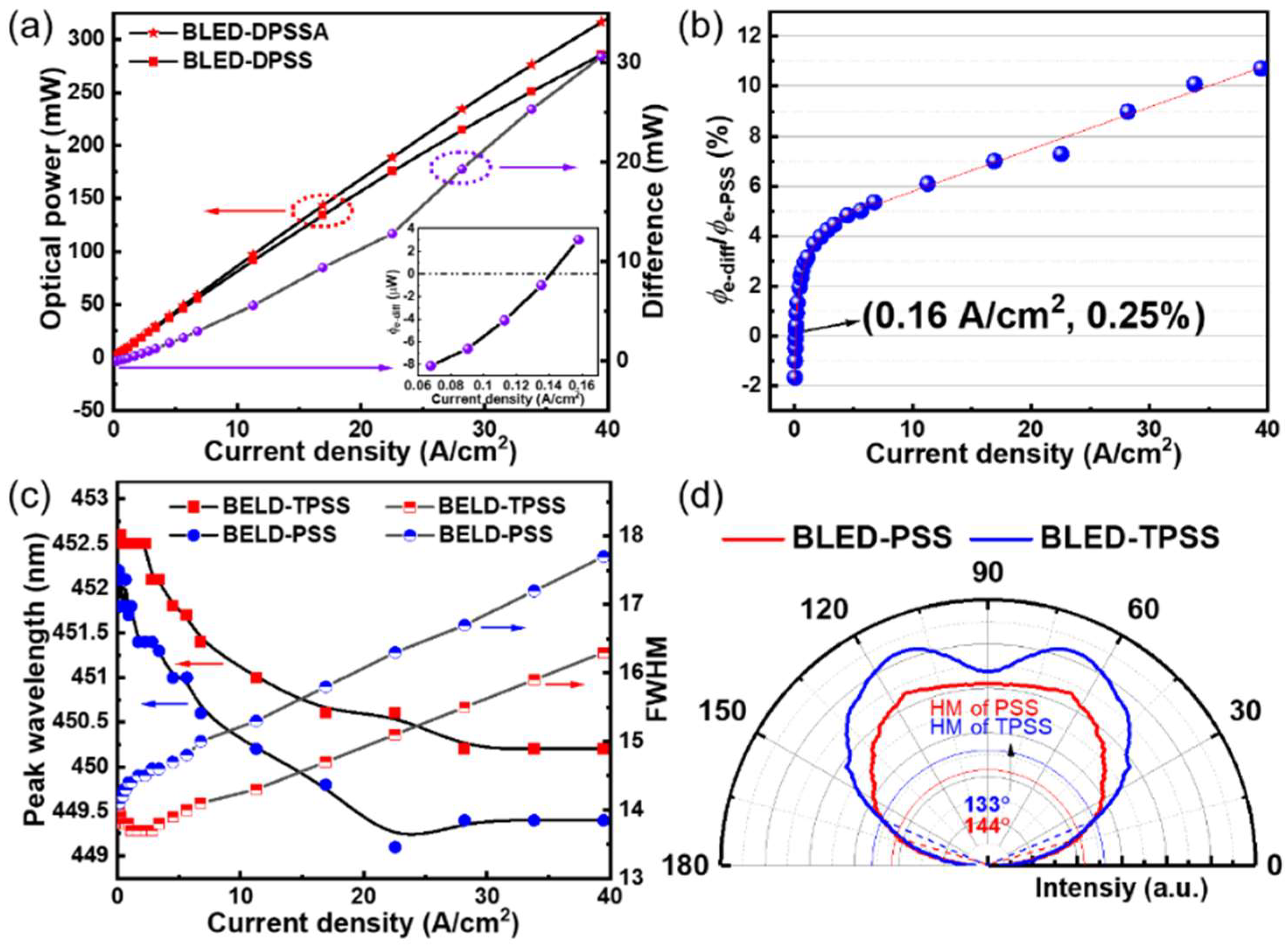
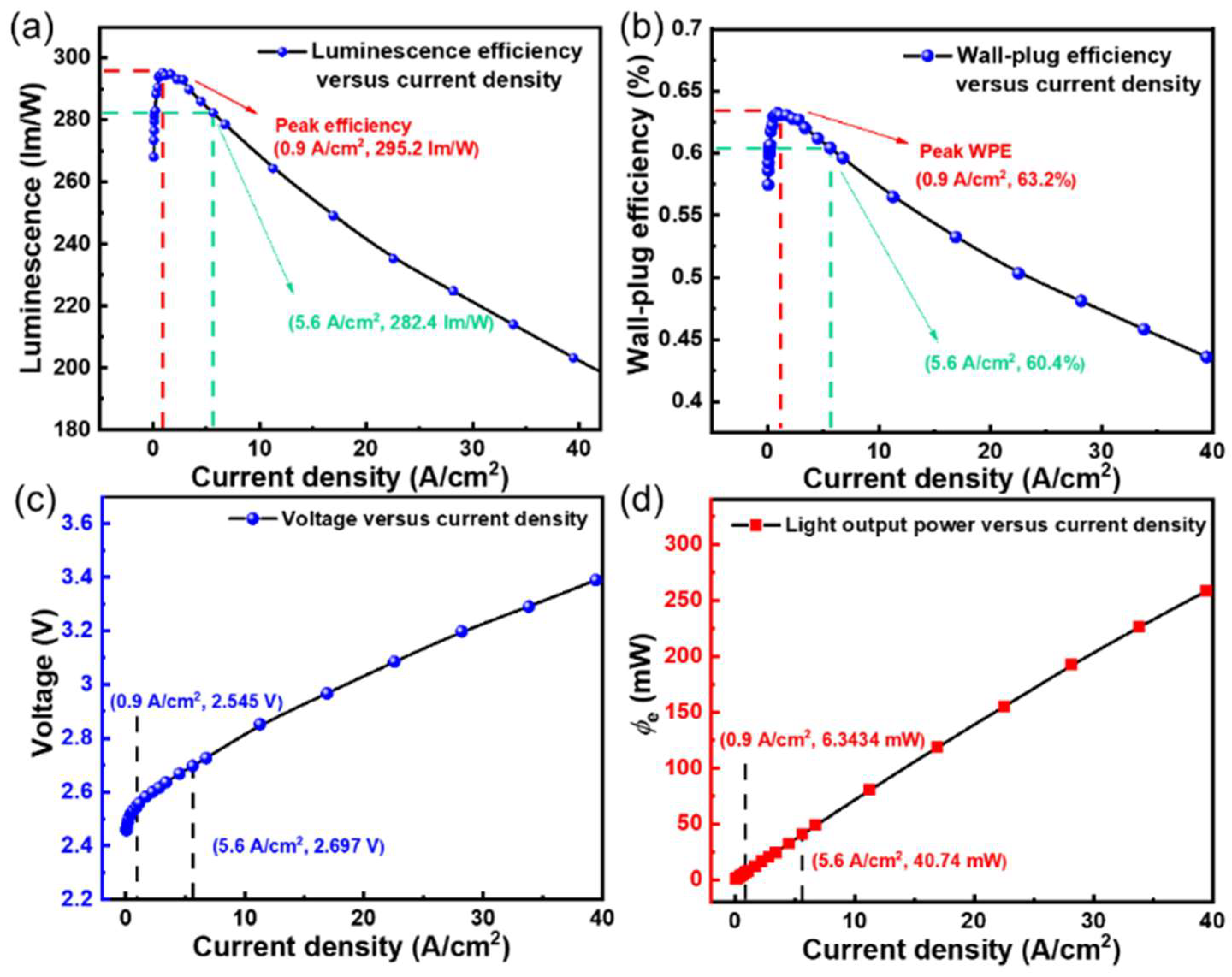
| Step | Temperature (°C) | Time (min) | NH3 (slm) | TMGa (sccm) | TEGa (sccm) | TMAl (sccm) | TMIn (sccm) | SiH4 (sccm) | Cp2Mg (sccm) |
|---|---|---|---|---|---|---|---|---|---|
| u-GaN | 1040 | 53 | 146 | 1490 | / | / | / | / | / |
| n-GaN | 1070 | 23 | 112 | 740 | / | / | / | 50.6 | / |
| InGaN/GaN pre-SLs-I (LOOP 3) | 860 | 2 | 90 | / | 490 | / | 1280 | / | / |
| 860 | 4 | 90 | / | 390 | / | / | / | / | |
| InGaN/GaN pre-SLs-II (LOOP 4) | 800 | 2 | 90 | 315 | / | 1125 | / | / | |
| 885 | 4 | 90 | 1010 | / | / | / | / | ||
| InGaN/GaN MQWs (LOOP 10) | 760 | 4 | 90 | / | 315 | / | 1125 | / | / |
| 885 | 8 | 90 | / | 1010 | / | / | / | / | |
| p-AlGaN EBL | 950 | 5 | 22 | 150 | / | 0–140 | / | / | 360 |
| p-GaN | 950 | 10 | 112 | 180 | / | / | / | / | 765 |
| p-GaN CL | 680 | 1.5 | 90 | / | 315 | / | 790 | / | 394 |
Publisher’s Note: MDPI stays neutral with regard to jurisdictional claims in published maps and institutional affiliations. |
© 2022 by the authors. Licensee MDPI, Basel, Switzerland. This article is an open access article distributed under the terms and conditions of the Creative Commons Attribution (CC BY) license (https://creativecommons.org/licenses/by/4.0/).
Share and Cite
Zhang, S.; Liang, M.; Yan, Y.; Huang, J.; Li, Y.; Feng, T.; Zhu, X.; Li, Z.; Xu, C.; Wang, J.; et al. High Luminous Efficacy Phosphor-Converted Mass-Produced White LEDs Achieved by AlN Prebuffer and Transitional-Refraction-Index Patterned Sapphire Substrate. Nanomaterials 2022, 12, 1638. https://doi.org/10.3390/nano12101638
Zhang S, Liang M, Yan Y, Huang J, Li Y, Feng T, Zhu X, Li Z, Xu C, Wang J, et al. High Luminous Efficacy Phosphor-Converted Mass-Produced White LEDs Achieved by AlN Prebuffer and Transitional-Refraction-Index Patterned Sapphire Substrate. Nanomaterials. 2022; 12(10):1638. https://doi.org/10.3390/nano12101638
Chicago/Turabian StyleZhang, Shuo, Meng Liang, Yan Yan, Jinpeng Huang, Yan Li, Tao Feng, Xueliang Zhu, Zhicong Li, Chenke Xu, Junxi Wang, and et al. 2022. "High Luminous Efficacy Phosphor-Converted Mass-Produced White LEDs Achieved by AlN Prebuffer and Transitional-Refraction-Index Patterned Sapphire Substrate" Nanomaterials 12, no. 10: 1638. https://doi.org/10.3390/nano12101638
APA StyleZhang, S., Liang, M., Yan, Y., Huang, J., Li, Y., Feng, T., Zhu, X., Li, Z., Xu, C., Wang, J., Li, J., Liu, Z., & Yi, X. (2022). High Luminous Efficacy Phosphor-Converted Mass-Produced White LEDs Achieved by AlN Prebuffer and Transitional-Refraction-Index Patterned Sapphire Substrate. Nanomaterials, 12(10), 1638. https://doi.org/10.3390/nano12101638







